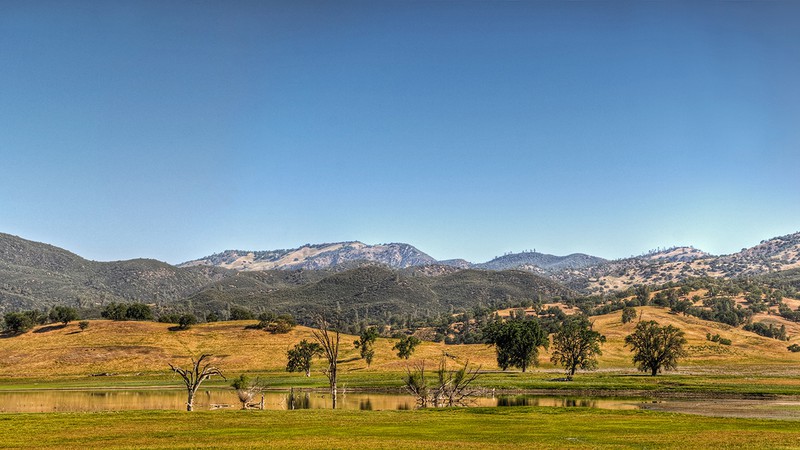Named after the local river, San Benito County continues to be shaped by the availability and distribution of water.

Hernandez Reservoir is among the water sources in San Benito County. Jeffrey T. Kreulen Shutterstock.com
Formed in 1874 by carving out part of the non-coastal region of Monterey County, San Benito County took its name from a body of water—a river, to be specific. The San Benito River, to be even more specific—a 109-mile waterway named by pioneering Spanish priest Juan Crespi after Saint Benedict, on the first day of spring in 1772, according to legend.
Like most regions of California, the availability and distribution of water continues to shape San Benito County to the present day. The county’s water needs, as would be expected, have grown with the population. Though it is now the 16th-smallest California county, San Benito County’s growth has been exponential, jumping from a population of just 1,000 in 1880 to almost 63,000 by 2019, according to United States Census Bureau estimates. So how has San Benito County kept up with the water requirements of its growing population?
The job of making sure the county has enough good water for household and business use, as well as for agriculture, falls primarily to the San Benito County Water District (SBCWD), which manages the county’s water supplies and provides water to two smaller water districts in the county. Created in 1953 as the San Benito County Water Conservation and Flood Control District, it subsumed the then-31-year-old Hollister Irrigation District.
The SBCWD also doubles as the county’s Groundwater Sustainability Agency. Under California’s landmark 2014 Sustainable Groundwater Management Act, every region with a groundwater basin that could be at risk of depletion must form a GSA, which then must come up with a Groundwater Sustainability Plan to show how it would reach sustainable groundwater levels within 20 years.
The SBCWD released its plan in July of 2021, posting the draft online for public comments, but the district noted in the draft that its plan would not force any reductions in pumping of groundwater. The county’s groundwater basin alone holds 500,000 acre-feet of water, with each “acre foot” equivalent to about 326,000 gallons. The Hernandez, San Justo and Paicines reservoirs, the three surface-water reservoirs in the county, hold about 31,000 acre-feet combined.
“Groundwater” is one of the most important sources of water anywhere. The term refers to water that, as the name implies, is naturally stored underground. The storage space for groundwater is known as an “aquifer,” and consists of all the spaces that exist below the surface where we all stand, sit and walk every day.
Like rivers, lakes and any other bodies of water, groundwater is not still. It flows through the aquifer at rates ranging from a few feet per day to mere centimeters per century. How is groundwater extracted for human use? By pumping it out through wells, which can range from shallow wells used mostly for residential customers to deep wells that supply public agencies, industry and agriculture.
But even the county’s groundwater supply isn’t enough. The SBCWD also imports water from the Central Valley Project, a federally managed, 400-mile network of reservoirs, dams, hydroelectric plants and other water facilities under the jurisdiction of the United States Department of the Interior’s Bureau of Reclamation. The San Benito district manages and delivers CVP water through the San Felipe System, which itself is a network of water facilities that includes four pumps, 11 percolation sites—where surface water is filtered back underground through the soil to refill the groundwater basin—and the San Justo Reservoir, which stores the piped-in CVP water, all connected by 170 miles of buried pipes.
The San Felipe System also helps the district supply water to the Sunnyslope County Water District. The Sunnyslope district was created in 1954, just a year after the SBCWD, to bring water to what was then an area east of Hollister—the county’s largest city, where approximately half the population resides. Some areas of the district have since been annexed into the city, but Sunnyslope has retained responsibility for their water needs.
The City of Hollister also serves as its own water district, but in 2019 signed an agreement with both the SBCWD and Sunnyslope to supply it with water. Under the plan, the districts would create a system of new wells, pipelines, treatment plants and storage tanks to funnel 6,000 acre-feet to residents and businesses in a two-phase operation.
The three districts, starting in 2017, have collaborated on the Hollister Urban Area Water Project. A 2014 civil grand jury report on the project, then in the planning stages, said that the program “ensures access to high quality water, by adding more surface water to the mix, thus reinforcing the reliability and availability of water for the economic vitality of all residents. It does this while simultaneously making it possible to reduce the salt concentration in our groundwater.”
A fourth entity, the Pacheco Pass Water District, is the oldest of the San Benito County districts, founded in 1931, but also the one that accomplishes the least. The district, which overlaps San Benito and Santa Clara counties, has only one function, according to a report by the Santa Clara County Local Agency Formation Commission. That is to “capture, store and release local water in order to recharge groundwater in the area.” The district does not sell water or store it for household or business use.
The population of the district, according to the LAFCO report, is just 863—but the Pacheco Pass District does not even know whether the water demands of that population “had changed in recent years, as it does not track the amount of groundwater pumped by each landowner, groundwater levels, or the amount of water released through the dams.”
In 2015, the San Benito County LAFCO attempted to dissolve the Pacheco Pass Water District, but the district is still around today.
Long form articles which explain how something works, or provide context or background information about a current issue or topic.